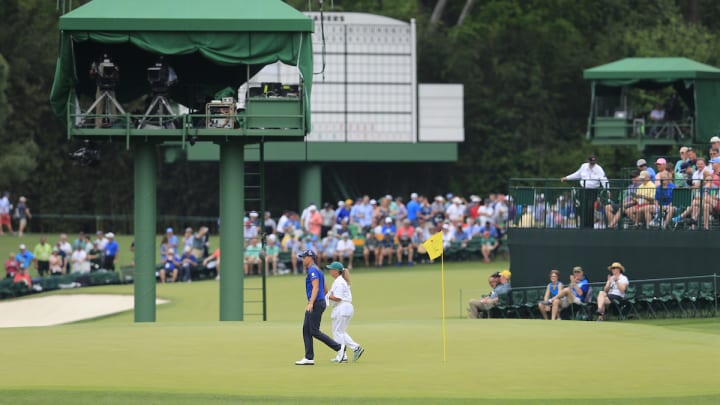Masters 15th Hole: Stats, History, Memorable Moments From Augusta National’s Par-5 ‘Firethorn’

A closer look at Augusta National Golf Club's 15th hole for the Masters:
Name: Firethorn
Par: 5
2022 yardage: 550
1934 yardage: 485
2021 scoring average: 4.77
All-time scoring average: 4.77
All-time difficulty rank: 17
Lowest year: 4.50 (1991)
Highest year: 5.09 (1998)
THE LAYOUT
The hole plays straight ahead and is relatively wide open until the fairway pinches farther down and begins a gradual slope down to a pond that fronts the green. Where the rough juts in on the left, there is a small group of trees that do not affect drives as much as they do the second shot. A well-placed drive will beg the question: Go for the green or lay up? In addition to the pond that is the width of the green, factoring into the equation is a closely mown uphill embankment to the green, which slopes from back toward the pond. Due to the speed of the green, balls rolling back toward the green's front tend to keep rolling down the slight slope and into the pond. There is also a bunker to contend with just right of the green’s front corner.
SIGNIFICANT CHANGES
1955: Gene Sarazen Bridge dedicated.
1957: Bunker added to front right of green.
1961: Pond in front of green enlarged.
1963: Mound at rear of green removed and mound on right extended.
1964: Bunker at right of green enlarged.
1969: Tees split, moving Masters tees to rear and right. Mounds added in fairway on right side.
1999: Fairway mounds reduced, and pine trees added to right and left.
2006: Masters tees moved back 25-30 yards and shifted approximately 20 yards to the golfer’s left.
2009: Eight to 9 yards added to front of the Masters tees. No change to yardage.
2022: Masters tees moved back 20 yards and fairway recontoured.
Notes: A 1933 New York Times article said of the 15th hole: “The hole has certain characteristics of the first hole at St. Andrews.”
ODDS AND ENDS
In 1968, Bob Goalby hit a 3-iron to 8 feet in the final round and made eagle. The 3 drew Goalby even with Roberto De Vicenzo, who later signed for an incorrect scorecard that showed a score one shot higher than he actually made on the 17th. That one shot kept De Vicenzo from a playoff with Goalby, who slipped into that year’s green jacket. … There were reportedly just 22 greenside spectators, including Bobby Jones, when Gene Sarazen hit his miraculous double-eagle shot in 1935. Renowned sports writer Grantland Rice embellished the total to 2,000 who had seen the shot. Also that year, Craig Wood held such a wide clubhouse lead on Sunday that the media persuaded Wood and his wife to pose for a picture with the winner’s check. … There is also a dark side to the par-5 15th, evidenced in the hole’s high score of 13, by Sergio Garcia in 2018. … The hole has been played in 6 under for the week eight times. …. Perhaps a much larger crowd remembers what would be the hole’s most memorable moment had it not been for Sarazen’s feat 51 years earlier. In 1986, 46-year-old Jack Nicklaus, winner of five Masters already, was in a Sunday hunt for a sixth green jacket. The day began with 14 players either tied with or ahead of Nicklaus, who methodically worked himself into contention — and frenzied adoring galleries — as the day wore on. As Nicklaus walked the start of the 15th, Seve Ballesteros, who eagled the 13th hole just moments earlier, led Nicklaus by four strokes. Nicklaus’ 4-iron second shot nearly flew into the cup, but skidded to 12 feet, and the Golden Bear converted that putt for eagle. Nicklaus created more roars with a birdie at the par-3 16th, so by the time Ballesteros readied for his approach into the 15th green, the Spaniard’s lead over Nicklaus had been cut to one stroke. Ballesteros, seeking his third Masters title, found the pond and made bogey. Nicklaus posted a final-round 65 and finished at 9 under. Ultimately, Ballesteros three-putted the 17th green to end his hopes; Tom Kite missed a 12-foot birdie putt on the 18th green that would have tied Nicklaus at 9 under; and Greg Norman, who made consecutive birdies at Nos. 14-17 to tie Nicklaus at 9 under, pushed his approach on the final hole and made bogey.
MEMORABLE MOMENT
1935: Gene Sarazen’s double eagle has been referred to as “the shot heard ’round the world” and one that helped establish the Masters. When Sarazen and playing competitor Walter Hagen stepped to the tee in the final round’s penultimate pairing, Sarazen sat at 3 under par, three strokes behind clubhouse leader Craig Wood. After a drive that found a divot, Sarazen used a newly designed 4-wood, known as the Wilson Turf Rider and reportedly created by Sarazen, for his approach from 230 yards. The 5-foot-5-inch Sarazen played the ball back in his stance and let rip. Bobby Jones later wrote, “His swing into the ball was so perfect and so free, one knew immediately it was a gorgeous shot.” The ball hit in front of the green, changed its direction slightly to the left and rolled into the cup. Sarazen would win a 36-hole playoff against Wood the following day to win his seventh major and complete the career Grand Slam.
SEE MORE OF AUGUSTA NATIONAL'S BACK NINE
10 | 11 | 12 | 13 | 14 | 15 | 16 | 17 | 18
